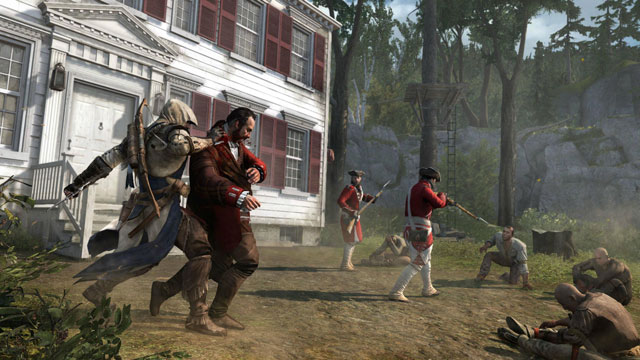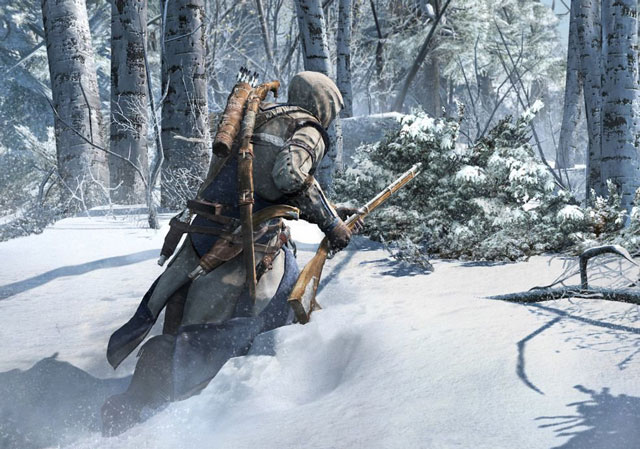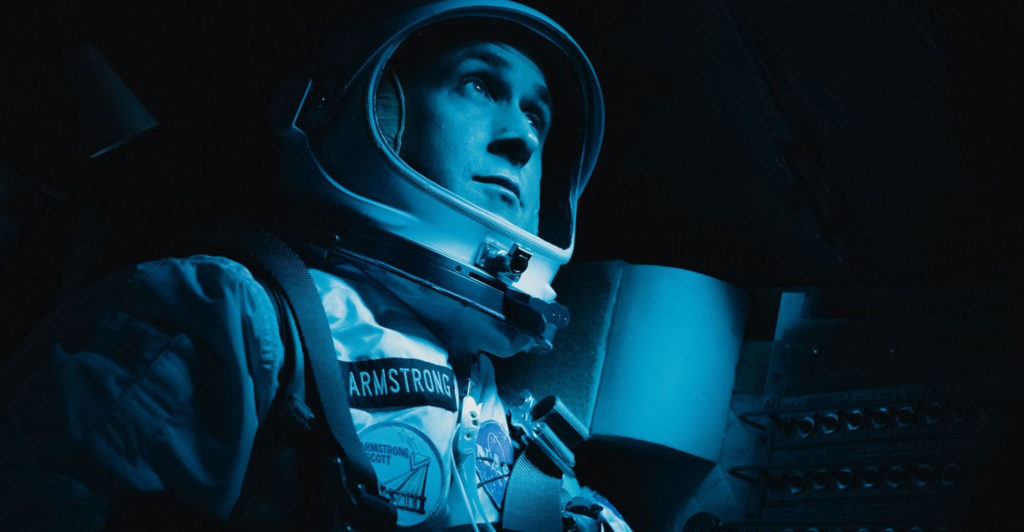Bringing with it a new lead character and a change of setting, Assassin’s Creed 3 promised a rebirth for a franchise that has become bloated and directionless over the past two years. But rather than seizing the opportunity to trim the fat, Ubisoft has turned in yet another overstuffed, unfocused game that offers joy and frustration in equal measure.
Assassin’s Creed 3, like the other games in the series, plays out across multiple timelines. In the present day, the player once again takes the part of bartender Desmond Miles. He is a descendant in a line of assassins who have fought a secret war, spanning centuries, with the ruthless and power hungry Templars.
When strapped into a machine called the Animus, Desmond is able to tap into his genetic memory bank and relive the exploits of his ancestors to uncover secrets and artifacts that will aid the assassins in their struggle with the Templars. This time around, he (and the player through him) spends most of his time reliving the struggles of Connor, a frontier youth with English and Native American blood living on the east coast of America at the time of the War of Independence.
Though Connor’s time period and ancestry gives him access to some new tools such as a tomahawk, bow and arrow, and muskets, he doesn’t play all differently to Ezio Auditore, the star of the previous three games. Most of his main missions are about tracking and assassinating Templars who are working to advance their organisation’s goal of taking control of the world.
The game spins out the same mixture of hand-to-hand combat, free-running environmental traversal and stealth as its predecessors, once again complemented by a range of mini games, side missions and optional activities. The amount of content Assassin’s Creed offers across the wilderness and its major cities of New York and Boston is staggering.
You can hunt animals in the wilderness, send caravans out to trade, groom a crew of assassins and dispatch them on missions, build and manage a thriving business at your farmstead, play board games in pubs, hunt down a wide range of collectibles, capture Templar forts, serve as a courier and errand boy, and much more.

Yet the quality of these activities is wildly variable, with many of them offering such meager rewards in the game or enjoyment that only slavish completionists will see the point. Like Brotherhood and Revelations before it, Assassin’s Creed 3 is full of half-shaped game mechanics that are not much fun in themselves and which do not gel with the rest of the game.
The best of the lot is a naval warfare game that puts you at the helm of a ship as you brave stormy weather and turbulent seas to fire broadsides at Redcoat battleships. It’s a visceral mini game with tight controls and a sense of heft and consequence missing from many of the other activities Ubisoft has crammed into the game.
Since the side missions and mini games aren’t the meat of the game, they’re easy enough to ignore. That brings up my biggest quibble with Assassin’s C reed 3, which is that the core mechanics have become stale and shaky. Assassin’s Creed 3 is often not very good at the things that are right at its centre.

Whether I was getting into a scrap, or trying to get from one end of New York or Boston to the other, or doing my best to creep up to an assassination target, the clumsiness of Assassin’s Creed 3’s controls and its lack of consistent feedback and cues constantly frustrated me. A few missions even have instant-fail conditions that you’ll only discover through trial and error.
Despite its many problems, Assassin’s Creed 3 offers a few hints of brilliance, whether it’s seeing the Boston Tea Party unfolding, surveying the frontier wilderness from a treetop or bumping into historical characters like Paul Revere or George Washington.
HOW IT SCORES
Graphics: 7/10
The frontier wilderness and the cities of Boston and New York are beautifully realised. But texture pop-in, omnipresent fog and frequent frame-rate drops seem to indicate that the ageing consoles don’t have the muscle to carry Ubisoft’s vision.Sound: 6/10
The voice acting is decent, but Lorne Balfe’s score doesn’t compare to Jesper Kyd’s superlative work in earlier Assassin’s Creed games.Gameplay: 5/10
The core stealth, combat and free-running mechanics in Assassin’s Creed 3 feel a bit long in the tooth, while many of its other gameplay mechanics and systems are half-baked. And control and camera issues crop up from time to time, too.Value: 7/10
There’s at least 40 hours of single-player content here, as well as an extensive multiplayer mode, but not all of it is engaging enough to be worth your time.Overall: 5/10
There are enough glimpses of brilliance in Assassin’s Creed 3 to make this frustrating, ambitious, intriguing, bloated and uneven game worth a look if you’re a fan of the franchise.
At its best moments, the assassin part of the game comes together well, with you gracefully dashing across the rooftops of 18th century New York, creeping up on a target and taking him down quickly and quietly. But those moments are not quite as abundant as you’d like them to be. The pure assassination part of the game is perhaps best represented in the multiplayer part of the game, this time enhanced by a fantastic new co-op mode called Wolf Pack.
Games such as Batman: Arkham City and Sleeping Dogs have shown that it is possible to balance open world environments with tight, refined gameplay mechanics. They succeed by doing slightly fewer things, but doing them all well. I can’t help feeling that Assassin’s Creed 3 could learn from their focus and discipline. Fewer mini games and better core mechanics and missions are just what this franchise needs to become great again. — (c) 2012 NewsCentral Media
- Reviewed on Xbox 360. Also available on PS3. Windows PC version due late this month




